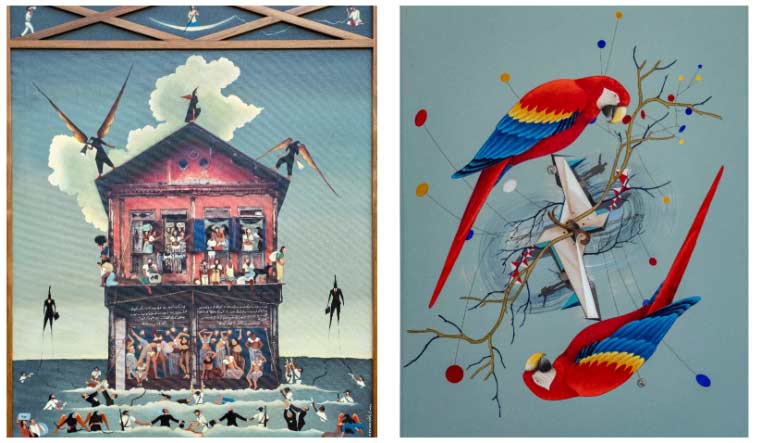Seven spiffy galleries in Delhi, working on the frontlines of the contemporary art scene, came together to showcase a commendable harvest of new wave works. At the fifth edition of the Delhi Contemporary Art Week (DCAW), which concluded on September 7, connoisseurs and enthusiasts alike got a peek into the zeitgeist in moving, poetic, mystical expressions. Blueprint 12, Exhibit 320, Gallery Espace, Latitude 28, Nature Morte, Shrine Empire and Vadehra Art Gallery - incidentally all helmed by women - presented an exciting line-up of artworks and walkthroughs at Bikaner House. THE WEEK highlights a selection of standouts.
1. Baaraan Ijlal
Hostile Witness: Grant Road Bombay
Acrylic, Archival Ink, Wood frame: Moonis Ijlal
Ijlal's meditation on cities and their stories is part of a group exhibition curated by Meera Menezes, titled "Legal Alien”. It explores the notion of alienation and looks at the possible factors that could lead to it. Is it the rapid march of technology? Or is it the city and the anonymity it bestows on its denizens that creates this estrangement? Artists in the group-show ponder and interpret alienation in several different ways.
2. Jagannath Panda
The Balancing Act
Acrylic, fabric and glue on canvas
Vadehra Art Gallery
Panda's works home in on the disjuncture that exists in our contemporary understanding of nature. His works emphasise nature's own mind and muscle to establish itself over a degenerate, man-made world. In The Balancing Act, two parrots support each other in their pursuit of a nest which looks like a turbine - intrusive and artificial rather than nurturing. The parrots end up being each other's true resting place.
3. Divya Singh
Slowly/Drift
Oil on canvas
Shrine Empire
Slowly/Drift is also a part of the group show Legal Alien and the canvas deftly captures the essence of a journey to be undertaken alone. Divya Singh translates her memories of isolation into a poetic rendition through her paintings. She navigates the dark void within every human being that lies between the outside world and their perception. Her series 'Do You Know How The Sun Laughs?' extends this introspective dialogue about human agency within nature and society through moments of spiritual awakening experienced during solitude.
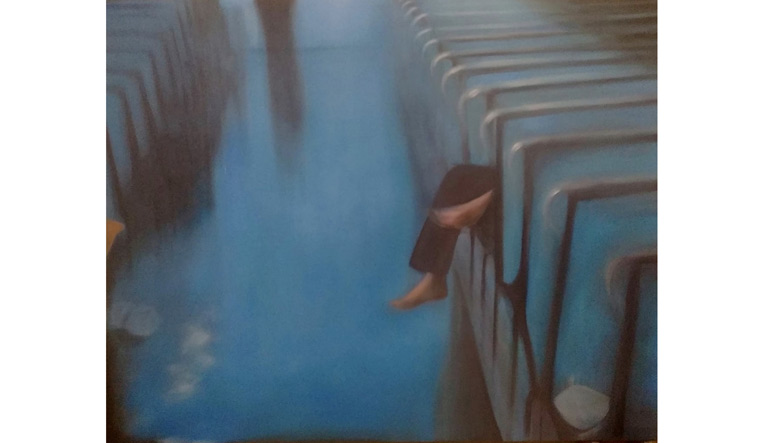 Divya Singh's Slowly/Drift
Divya Singh's Slowly/Drift
4. Anupama Alias
Island of Curiosities
Mixed media on paper
Latitude 28
Alias depicts women at a transitional and vulnerable time in their lives, specifically the middle years. Her work focuses on people, transitions, identity and the "in-betweenness" of existence. The intriguing reason behind how Eve was made from Adam's rib became the genesis of her work whereby she began exploring human anatomy. The ribcage became the spine of Alias's works which allowed her to examine other body parts, something that helped her embark on a metaphysical journey of self-discovery.
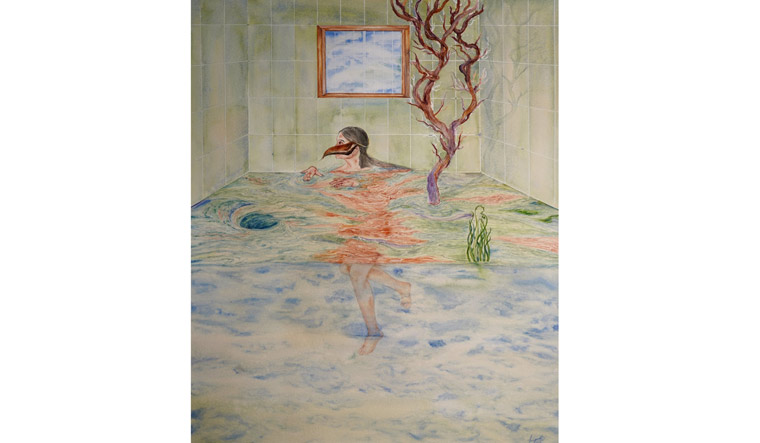 Anupama Alias's Island of Curiosities
Anupama Alias's Island of Curiosities
5. Praneet Soi
Untitled
Acrylic on Canvas
Vadehra Art Gallery
Soi draws his inspiration from the Progressive artists of the mid-20th century, particularly in the way they marry figuration and formalism. His open-ended narratives contend with a return to materiality.
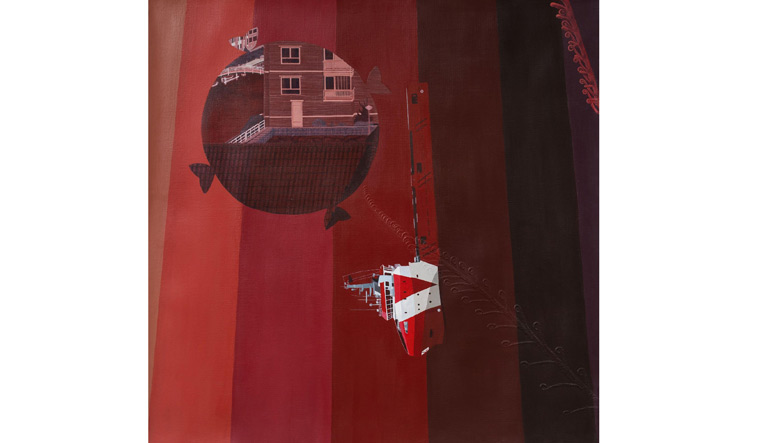 Praneet Soi's untitled artwork
Praneet Soi's untitled artwork
6. Rashmi Mala
Companion Plants
Natural pigment with casein, cyanotype and touch of gold leaf on paper
Gallery Espace
Rashmi Mala's plant drawings reference colonial botanical representations and are overlaid with elements drawn from historical texts and art-making processes. Her series "Companion Plants" is a metaphor of the minor, the unseen and the unheard of plants that surround us. "Growing plants and painting plants go hand in hand," says the artist.
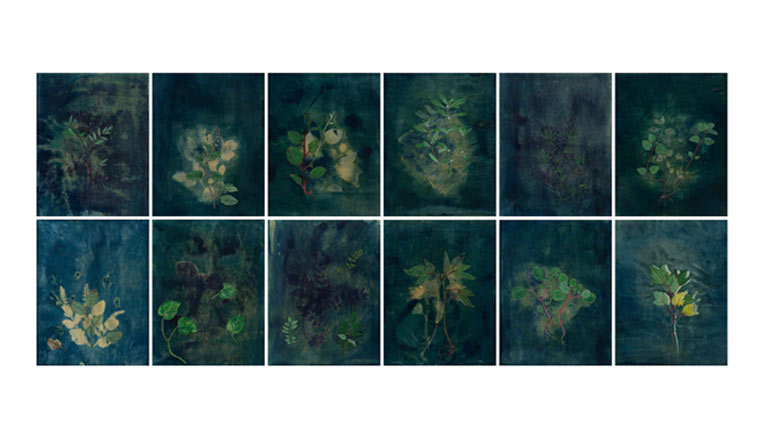 Rashmi Mala's Companion Plants
Rashmi Mala's Companion Plants
7. Kingsley Gunatilake
Red cross on blue
Old book, Metal
Blueprint 12
Kingsley explores artist’s books which focus on the long and terrorised history of Sri Lankan civil war that lasted for over three decades, leaving a trail of dead memories and empty bullets amidst promises of reconciliation by politicians in its wake. Gunatilake questions the aftermath of war and the rationality left in their inheritance. The spine of his book practice is inspired from the burning of the Jaffna Library in 1981, which is reiterated through a meditative practice of burning and cutting; an act of remembering and that of a witness.
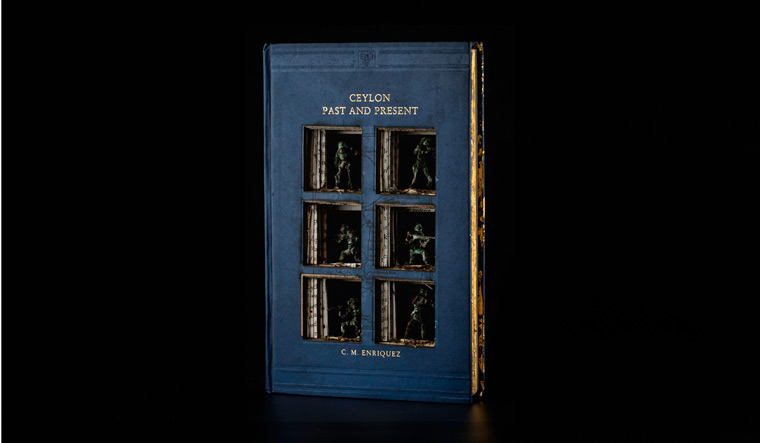 Kingsley's Red cross on blue
Kingsley's Red cross on blue
8. Kumaresan Selvaraj
Untitled
Mixed Media
Exhibit 320
Selvaraj’s approach is modernist in nature, incorporating local and regional elements to create what he terms a ‘national modernism’. His use of different kinds of paper, in layered forms, represents various facets of human existence. He arranges multiple colors of paper into tightly compressed layers. The sculptural arrangements almost always appear to be on the brink of overflowing, and as a result imbued with dynamic energy.
 Selvaraj's untitled artwork
Selvaraj's untitled artwork


